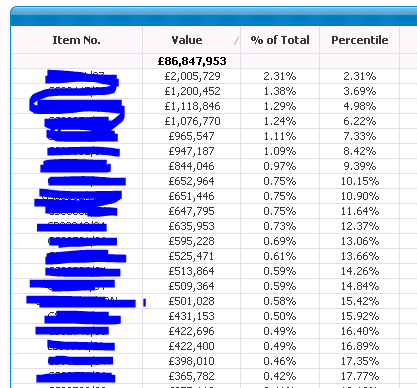Unlock a world of possibilities! Login now and discover the exclusive benefits awaiting you.
- Qlik Community
- :
- All Forums
- :
- QlikView App Dev
- :
- Re: Straight table dimension limit for a range of ...
- Subscribe to RSS Feed
- Mark Topic as New
- Mark Topic as Read
- Float this Topic for Current User
- Bookmark
- Subscribe
- Mute
- Printer Friendly Page
- Mark as New
- Bookmark
- Subscribe
- Mute
- Subscribe to RSS Feed
- Permalink
- Report Inappropriate Content
Straight table dimension limit for a range of accumulated percentages
Hi Guys,
Before we get started I believe what I'm asking may not be possible in Qlikview, but thought it would be worth posting before finally accepting that is the case.
A bit of context on what I'm after...
I've been tasked with creating a dashboard which shows the largest stock value/volume amount in descending order, with a culmilative percentage sum to allow our users to see cut of points such as 10%,30% of total etc.
Unfortunately this data set needs to be dynamic so I am having to use Qlikview's inbuilt chart accumulation features rather than going down the RangeSum/Above syntax route.
What we're left with is a straight table with 1 dimension, [Item No], which looks something like this:

With the following expression being used to calculate the percentile field:

Bearing in mind I am using the 'Full Accumulation' selection on the [Percentile] field to get this to calculate correctly.
I then have a slider on the page which is setting the value for a variable 'vPercentile' to limit the data relative to the accumulated total:

This is all fine and is working as expected, this is where the problem arises...
I have now been asked if it would be possible to limit the data between specific %s, for example 60-80% of the total.
I know this is possible as I have used a multislider before, however this has always been with an actual date field rather than a variable.
For this specific problem I am struggling to see how it would be possible, as my field [Percentile] is not viewed as say 61% outside of the straight table where the accumulation is taking place.
Is it possible for me to set a range using variables within the dimension limits tab, for example something along the lines of:
vMinPercentile = 60
vMaxPercentile = 80
> vMinPercentile , < vMaxPercentile
I cant see how this would work as there is no field to actually base these filters against as I cannot reference the expression within the dimension limit expression box.
Any help with this would be appreciated or just the knowledge that what I have said is correct and with these specific criteria this is impossible.
Cheers
Jim
- Mark as New
- Bookmark
- Subscribe
- Mute
- Subscribe to RSS Feed
- Permalink
- Report Inappropriate Content
RangeSum(Above()) can work if you happen to have QV12.1 or above.... do you?
- Mark as New
- Bookmark
- Subscribe
- Mute
- Subscribe to RSS Feed
- Permalink
- Report Inappropriate Content
Unfortunately not, I'm still on 11.2...
My mistake, as I forgot to mention that in the initial post.
I believe I read that specific post from Henric before, however no help in my situation.